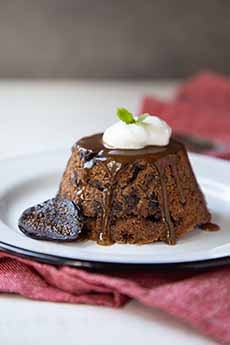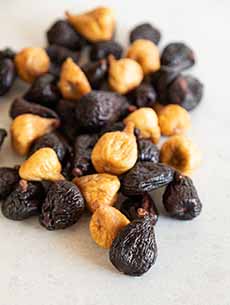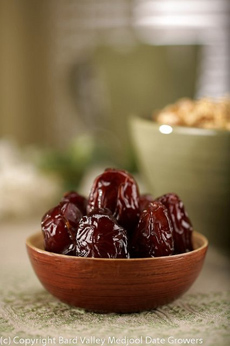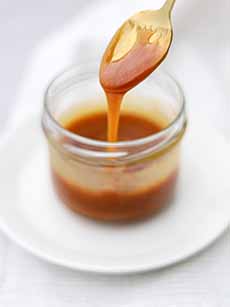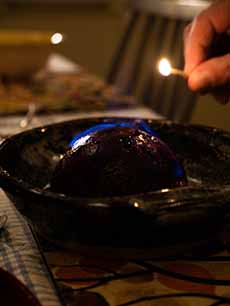Oh Give Us A Figgy Pudding Recipe (aka Christmas Pudding, Plum Pudding)
|
|
What is a figgy pudding, also known as Christmas pudding and plum pudding.? Discard any thoughts of creamy American puddings. British puddings are steamed cakes. When Christmas carolers ask to be given some figgy pudding, they can be handed a slice in a napkin. A Christmas pudding is essentially an alcohol-soaked, boiled or steamed fruit cake. Boiling creates a similar dense texture as baking, but moister. They can also be made without alcohol, like the recipe below. If you wish, you can stir brandy or rum into the caramel sauce after you remove it from the heat. National Plum Pudding Day is February 12th (coincidentally, Abraham Lincoln’s birthday). You’ll need a jumbo muffin tin for this recipe, which turns out six individual plum puddings. You can use a regular muffin tin for 12 smaller servings. You can add a scoop of vanilla or eggnog ice cream in addition to, or instead of, the caramel sauce. Prep time is 10 minutes. Cook time is 26-28 minutes. Ingredients For 6 Servings 1. PLACE the figs in a medium bowl. Pour the brandy over the figs. Cover and let rest at room temperature for 6 to 8 hours. 2. PREHEAT the oven to 350°F. Grease the 6 wells of a jumbo muffin tin with butter. 3. MAKE the cake the cake. Cream the brown sugar and butter together in a large bowl until light and almost fluffy, about 3 minutes. Mix in the eggs. 4. RESERVE 2 tablespoons of the fig’s soaking brandy, then strain the figs and discard the rest (we repurposed it and add it to our coffee!). Mix in the figs, the reserved brandy, and the dates. Add the salt and stir in the flour until combined. 5. TRANSFER an equal amount of batter to each of the 6 muffin wells. Use a buttered spoon to smooth the top of each as much as possible. Bake for 26 to 28 minutes, until the puddings are firm in the center, but still soft. Be careful not to overbake. You want the batter to be baked through, but for the cake to remain soft. 6. REMOVE the tin from the oven and let cool in the pan for 5 minutes. While the puddings cool… 7. MAKE the caramel sauce. Melt all ingredients in a medium saucepan over medium heat. Bring to a boil and cook, stirring often, until the sauce begins the thicken, about 45 seconds. Remove from the heat. 8. PLACE a plate over the muffin pan and invert it to de-pan the puddings. Arrange them on individual serving plates and spoon warm the sauce over the top. Garnish with whipped cream and mint leaves. We added pomegranate arils for some color. Serve warm or at room temperature. The first records of plum puddings date to the early 15th century England, when a savory version made with meat and root vegetables, “plum pottage,” was served at the start of a meal. Back then, “plum” was a generic term for any dried fruit—raisins, currants, prunes, and other dried, preserved, or candied fruits. |
|
|
By the end of the 16th century, dried fruits were more plentiful in England, and plum pudding recipes moved from savory to sweet. By the mid-1600s, plum pudding was sufficiently associated with Christmas that when the Puritan Oliver Cromwell came to power in 1647, he had it banned as associated with Druidic paganism and Roman Catholic idolatry (also banned: Yule logs, carols, and nativity scenes). Across the pond, in 1659, the Puritan government of the Massachusetts Bay Colony actually banned Christmas! Here’s the story. When the Puritans were deposed in 1660 and the English monarchy was restored, so were Christmas pudding and the rest. By the 19th century, the pudding ingredients were standardized to include breadcrumbs, brown sugar, candied orange peel, currants and raisins, eggs, suet, sweet spices (allspice, cloves, nutmeg), and alcohol. The cake was soaked in brandy (or if preferred, rum or whisky) and set aside to mature for 30 days. Maturation preserved the Christmas pudding so that it could remain tasty for more than a year—and thus, it could be sent to soldiers and colonizers overseas for a holiday taste of home. The standard components of an English family Christmas were solidified during the Victorian era (1837-1901), including Christmas pudding. The pudding was considered so important that Christmas savings clubs helped poor housewives lay away pennies throughout the year, to purchase the costly pudding ingredients at Christmastime. In the U.S., Christmas pudding is mostly known from English literature and song. But there’s no reason why that has to be! Here’s more detail on the history of Christmas pudding. |
||
